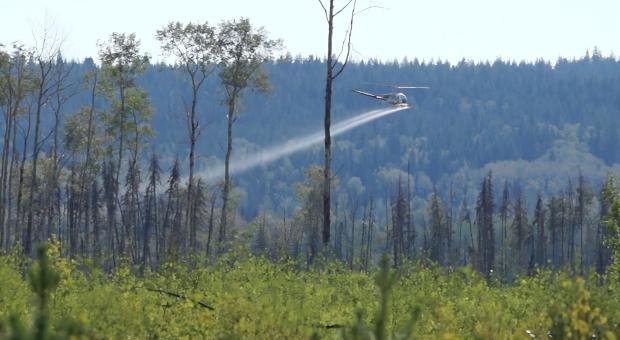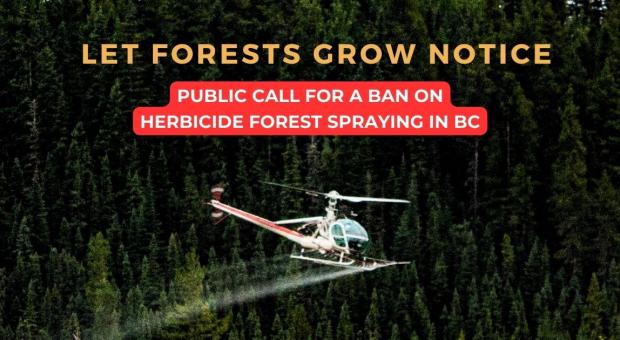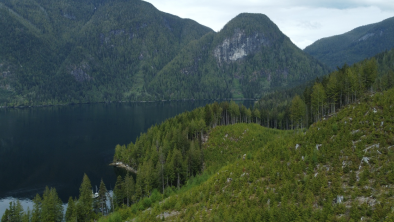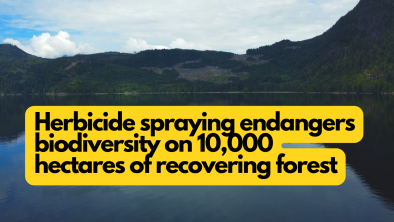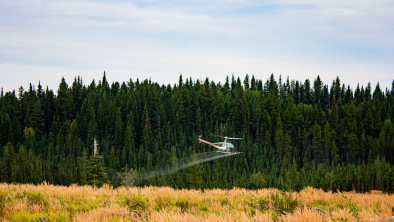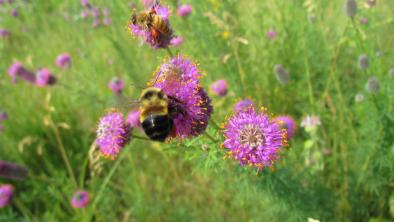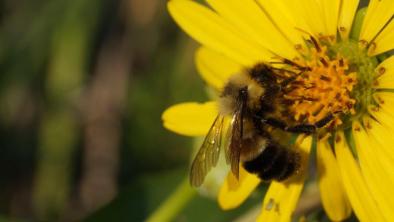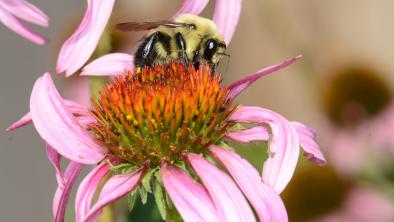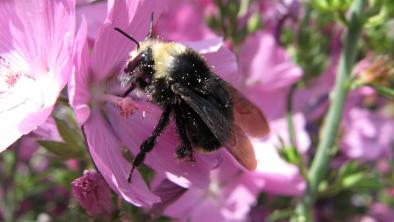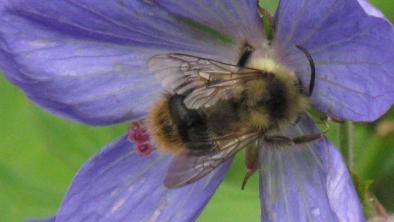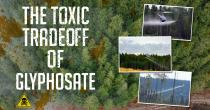We work to protect wild spaces for the benefit of bees and pollinators. We also work to shine a light on toxic chemicals used to control “pests” throughout the landscape. There is widespread chemical use throughout food systems, communities and wilderness. These chemicals, called pesticides, are having a devastating impact on bees and pollinators. The logging and agricultural industries may define pests as insects or unwanted plant species that are undesirable in monoculture crop systems, the practice of growing one crop species.
Neonics (neonicotinoid pesticides) are among the most common pesticides used to kill insects, used in the industrial agriculture sector. Glyphosate is one of the most common herbicides used to kill plants, fungi and bacteria and is used in many sectors including industrial agriculture and logging. Below is a breakdown of these two chemicals, their impacts, and what we are doing to combat their use.
Glyphosate
Glyphosate is a harmful substance that affects important bacteria, fungi and plants because they all have a similar metabolic pathway called the shikimate pathway, which glyphosate targets. Glyphosate does not discriminate -- it affects and often kills most plant species it comes in contact with. This can have serious indirect effects on ecosystems because it kills entire kingdoms of life necessary for the ecosystem to function.
Glyphosate is used in agriculture, logging and other sectors. In the logging industry, it’s used by companies to help grow cash-crop commercial species and kill non-profitable ones, creating a tree plantation rather than a diverse forest. Often these non-commercially profitable species are native plants that are important for wildlife, traditional food, medicine and overall ecosystem health.
After a company logs a forest, they go back to spray glyphosate, often from planes and helicopters in the sky where the chemical has far-reaching impacts on unintended species. Alarmingly, 93 per cent of endangered species in the US are likely harmed by glyphosate. Endangered monarch butterflies, bees and amphibians are also harmed by the deadly glyphosate cocktail. After they’re sprayed, forests become hotter and drier and more prone to devastating forest fires. The list of impacts goes on.
In some jurisdictions, like BC and Alberta, the spraying is required by law. In BC, the ironically named “free-to-grow policy” requires companies to establish a new crop of trees on land they log, and they use glyphosate to achieve this. New Brunswick has the highest rate of glyphosate use in forestry per land mass among the provinces. First Nation leaders in NB say the practice affects the ability of their communities to harvest the land.
Glyphosate is a controversial toxin that is harmful to ecosystems — that’s clear. What’s not clear is whether or not the harm is worth the benefits, even to corporations. The research of Dr. Suzanne Simard, author and professor of forest ecology, dives into the complexities of regrowing forests and found conifer forests don’t necessarily do better when broadleaf plants are killed off. Read more about the controversial use of glyphosate in our paper, The Toxic Trade Off.
We’ve launched a public campaign to tackle glyphosate’s use in the logging sector.
We’re working to expose logging company plans to spray glyphosate. Often, forests are sprayed without public knowledge and in certain provinces, like BC, the public is not given access to the maps that show exactly where they are spraying. This is a public health risk because glyphosate is a probable carcinogen and biodiversity killer. We’re ramping up our public education campaign as many people are not aware of the widespread use of glyphosate in forests. Ultimately we are calling on all provinces and territories to ban logging corporations from using glyphosate. Join us by taking action.
Web Map of Chemical Herbicide (including Glyphosate) Sprayed Cutblocks in BC
Neonics
This specific class of pesticides are harmful to bees and they’re slowly being recognized and banned all over the world. But Canada has been falling behind as other jurisdictions move to phase these pesticides out. For years the Wilderness Committee has been mobilizing the public, bringing attention to the dangers of neonics and pressuring governments to protect our pollinators by banning them. The Wilderness Committee gathered 10,910 signatures alone and combined with 14 other environmental organizations almost half a million Canadians signed a petition to ban neonics.
In 2018, Health Canada announced its proposal to finally ban two of the most toxic neonic pesticides in Canada. This was a big step in the right direction. In 2019, Health Canada completed its re-evaluations of three neonicotinoid pesticides clothianidin, imidacloprid and thiamethoxam where they announced the cancellation of certain uses of these pesticides. At first glance, this sounds like a clear win, but there’s always the fine print. Although these pesticides will be “cancelled” there will be a “phase-out” which allows the harmful pesticides to continue being used as-is until 2025. This is absolutely unacceptable since they’ve been proven to be harmful to pollinators.
We challenged this in court arguing that a phase-out is unlawful. Unfortunately, we lost the case although the judge reinforced the importance of science-based decision making. The phaseouts will still happen but over an extended period of time, which will sadly make pollinators pay the price.
2020 was supposed to be a big year for pollinators. But the federal government delayed making important announcements regarding the use of neonics. A final decision was supposed to be made in the fall of 2020 regarding banning outdoor uses of clothianidin and thiamethoxam to protect the environment. This is now the second time this decision has been delayed by Health Canada who said that new information would need to be reviewed before making a decision. We ensured the information being reviewed was science-based and submitted new evidence showing the harms of neonics on aquatic invertebrates. Health Canada pushed the decision off until the spring of 2021.
In March 2021 they released their decision to continue to allow the widespread use of neonicotinoid insecticides, despite evidence of harm to wildlife and ecosystems. While there were small incremental changes to reduce the use, such as a reduction in application rates, most uses of the pesticides continued. Instead, the Pest Management Regulatory Agency has focused on adding product labels as a solution, which will have negligible impacts.
We work with other bee advocates across the country to push for a complete, nationwide ban on these bee-killing pesticides – before it’s too late. Bees may be small, but the impact they have on our environment, and our daily lives, is immense.
Your much appreciated donation keeps this work going!
Get in on the action and make a difference!
Help spread the word!
For a visual and interactive version click here Check out our PDF version of the paper! POISONING NATURE FOR LOGGING PROFITS The death of a tree echoes through a valley as it descends to decomposers, becoming a nurse log. In its death, seedlings establish on top, gaining protection from disease...
